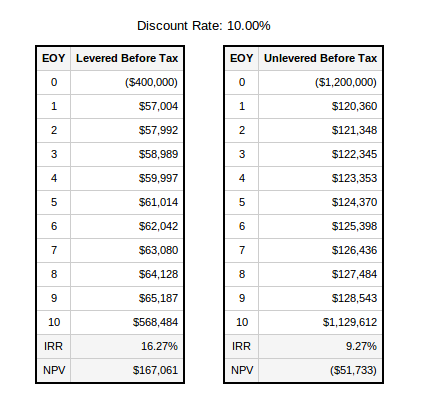
Value is traditionally defined as the power of a good to command other goods or services when exchanged. Within this broad definition of value, there are various types of value given to real property, such as investment value, market value, insurable value, assessed value, liquidation value, or replacement value. In this article we’ll go over different types of real estate value, and then zero in and focus on the difference between investment value and market value, which is often confused by commercial real estate professionals.
Types of Real Estate Value
First of all, let’s briefly go over several common types of commercial real estate value, then we’ll dive into the difference between investment and market value and clarify with an example.
Market Value is what’s typically meant when referring to a property’s value and is the value used for loan underwriting purposes. The Appraisal Foundation has a specific definition for market value as published in the Uniform Standards of Professional Appraisal Practice (USPAP). According to the Appraisal Foundation, market value is the most probable price a property would bring in a competitive and open market under all conditions requisite to a fair sale, with the buyer and seller each acting prudently and knowledgeably, and assuming the price is not affected by undue stimuli.
Investment Value refers to the value to a specific investor, based on that investor’s requirements, tax rate, and financing.
Insurable Value – This covers the value of the portions of a property that are destructible for the purposes of determining insurance coverage.
Assessed Value – Assessed value is the value determined by the local tax assessor to levy real estate taxes.
Liquidation Value – Liquidation value establishes the likely price that a property would sell for during a forced sale, such as a foreclosure or tax sale. Liquidation value is used when there is a limited window for market exposure or when there are other restrictive sale conditions.
Replacement Value – This is the cost to replace the structure with a substitute structure that is identical or that has the same utility as the original property.
A property can have any of the above types of value at any given time, with no two values necessarily being the same. This is an important point to remember when trying to understand the value of a commercial real estate property. This is especially true when determining market value and investment value.
Approaches to Market Value
Market value is what’s determined by an appraisal. During the commercial loan underwriting process, most lenders will require a third-party appraisal in order to determine a market value estimate, which is then used to find an appropriate loan amount and collateral value.
How do appraisers determine market value? First, before a market value can be estimated by an appraiser, the highest and best use for the property must be determined. The highest and best use is the legal use of a property that yields the highest present value. This process usually begins with evaluating the zoning laws to understand the legally permitted uses for the property.
Once the legally permitted uses are understood, the physically possible uses are then considered, within the bounds of the zoning ordinances. This takes into account the physical limitations of the property such as topography, size, layout, etc.
Finally, the financial feasibility is considered for all of the uses that are legally permissible and physically possible. The financially feasible use that produces the highest financial return is the highest and best use.
Once the highest an best use is determined, the appraiser can then determine market value. Appraisers may use three basic approaches to estimate market value: the sales comparison approach, the cost approach, and the income approach, using either the Direct Capitalization Method or the Discounted Cash Flow Model. We discuss each of these approaches in detail here, but below we’ll briefly summarize.
Sales Comparison Approach
The sales comparison approach links the value of a property to prices that recent buyers have paid for similar properties. In reality no two properties are exactly alike, but this approach can provide a reasonable estimation of value when there is a large quantity of recently sold comparable transactions.
Income Capitalization Approach
The income based approach to market value derives property value from the income it produces. The two methods used to value a property based on income are the direct capitalization method and the discounted cash flow valuation method.
Cost Approach
The cost approach bases value on the cost of reproducing a property, less any accrued depreciation. Accrued depreciation can come from three sources: physical deterioration, functional obsolescence, and external obsolescence. Once the replacement cost is determined and the accrued depreciation is netted out, the cost is added to the value of the land to determined an appropriate value based on cost.
Reconciliation of Value
In a full appraisal the above values are typically reconciled by using a weighted average to determine the final value estimate. For example, it may be determined that a higher weight should be given to the income approach because the available comparable sales data is weak, and as such this would be reflected in the final reconciled market value.
Approaches to Investment Value
While the market value process is usually used in appraisals for loan underwriting purposes, when deciding how much to pay for a property, investors also consider how much a property is worth. Investment value is the amount that an investor would pay for a specific property, given that investor’s investment objectives, including target yield and tax position.
Because investment value depends on an investor’s investment objectives, investment value is unique to the investor. As such, different investors can apply the same valuation methods and still come up with different investment values. Investors can choose from a variety of valuation methods when determining investment value, unlike appraisers who have to adhere to strict procedural guidelines. The following are the most common measures of investment value:
Comparable Sales (Comps) – This is the same sales comparison approach mentioned above that is used by appraisers. Typically investors will compare similar properties on a per square foot or per unit basis.
Gross Rent Multiplier – This is a simple ratio that measures investment value by multiplying the gross rents a property produces in a year by the market based Gross Rent Multiplier (GRM). The gross rent multiplier is usually derived from comparable properties within the same submarket.
Cash on Cash Return – The cash on cash return is another simple ratio used to determine investment value. It’s calculated by taking the first year’s proforma cash flow before tax and dividing it by the total initial investment.
Direct Capitalization – This is the same direct capitalization approach mentioned above that is used by appraisers. Capitalizing the income stream of a property is a very common and simple way to determine both market and investment value for a commercial property.
Discounted Cash Flow – The discounted cash flow model is used to find an internal rate of return, net present value, and a capital accumulation comparison. While the simple ratios above are quick and easy, they do come with several built-in limitation that are solved by a discounted cash flow analysis.
Investment Value vs Market Value
As shown above, market value is essentially the value of a property in an open market and is what’s determined by an appraisal. Investment value, on the other hand, is determined by an individual investor based on that investor’s unique investment criteria and goals.
Let’s take a quick example to illustrate this difference. Suppose an individual investor is contemplating the acquisition of a small apartment building and has projected the following cash flows:
As shown above, using the investor’s discount rate of 10%, the property generates a levered NPV of $210,820. This property is under contract with a total purchase price of $1,200,000 but the above analysis implies the investor could pay up to $1,410,820 and still achieve the target yield. Check out the intuition behind IRR and NPV to learn more about how this works.
The above levered analysis assumes that the investor can obtain a $960,000 loan (80% loan to value), amortized over 20 years at 5%. But suppose that during the underwriting process the bank orders a third-party appraisal and it comes in at $1,000,000 rather than the $1,200,000 the investor is paying. This also reduces the supportable loan amount to $800,000 (based on an 80% LTV) rather than the anticipated $960,000. Unfortunately, in this scenario it turns out that the seller refuses to sell for less than $1,200,000. In other words, this is an above market transaction where the investment value is higher than the market value. Does it still make sense to do the deal?
Let’s take a look at what the new cash flows look like to the investor in this new loan scenario:
As shown above the new loan amount reduces the yield to 16% from 22%. But this still exceeds the investor’s required return of 10%. So, does it make sense to do the deal? As always, it depends.
In most cases the investment value and the market value should be approximately equal, but sometimes these two values will diverge. On the one hand investment value can be higher than market value. This can happen when the value to a particular buyer is higher than the value to an average, well-informed buyer. For example, this might be the case when a company expands to a new building for sale across the street, paying more than market value in order to keep competitors out of the sub-market. The additional value over and above the market value provides a strategic advantage and therefore might be justified. In the case of an investor, investment value could sometimes be higher than market value due to favorable financing terms or tax treatment that is non-transferable.
On the other hand, investment value can be lower than market value. This might be the case if the particular asset class in question is not a property type that you specialize in. For example, if you are primarily a multifamily developer, then decide to evaluate a site for possible hotel development, your internal investment value may be less than the market value due to the steeper learning curve costs involved. Additionally, investment value could be lower than market value if you require an above-average return based on your existing portfolio mix. In these cases it can sometimes be tempting to pursue a deal even though investment value is less than market value. In these cases think carefully before getting distracted by something that might not make sense.
Conclusion
The safest policy is of course to make sure a transaction makes sense both from an investment value perspective as well as a market value perspective. Keep in mind that investment value is much more subjective than market value, and as such it can be abused. To avoid falling victim to investment value abuse, it’s best to always estimate market value whenever a relevant market exists. Be especially skeptical if someone claims that investment value differs from market value in a way that supports his or her sales pitch. They might be right, but as the saying goes, trust but verify.
Source: Difference Between Market Value and Investment Value in Commercial Real Estate
https://www.creconsult.net/market-trends/difference-between-market-value-and-investment-value-in-commercial-real-estate/
No comments:
Post a Comment